Portable Funny Amusing Palm Pressure Mini Fan Fruit Shape Cute Squeeze
Palm trees are synonymous with tropical beaches, warm sunny climates, and cute landscaped gardens. Palms are recognized by their fan-shaped or feather-like fronds (leaves) and fiber-covered trunks or stems. Most types of palms such as date palms and coconut palms abound in warm countries. However, some species of palms are tolerant of temperate climates and cold temperatures. Some varieties of palm trees can also grow indoors as houseplants.
The most popular varieties of palm trees are Pygmy Engagement palm, Pindo Palm tree, Triangle palm plant, Mediterranean dwarf palm, Mazari palm, Dwarf Majesty palm tree, Christmas palm tree, Bottle palm tree, Canary palm tree, Sylvester palm, Chinese Fan palm, Palmetto palm tree, and Mexican palm tree.
Palm trees are a type of evergreen plant belonging to the Arecaceae family unit of plants. There are over 2,600 species of palm trees that are grouped into over 200 genera. Palm trees are classified by their branchless stems and showy big evergreen leaves.
Different types of palms as well grow to varying heights. For example, types of coconut palms with their long wispy leaves can grow to well-nigh 100 ft. (30 m) tall. Date palms with their succulent sweet date fruits can abound to 75 ft. (22 yard).
Some modest palm trees are perfect for planting in gardens as they just reach heights of 6 to ix ft. (ane.8 – 2.7 m) tall. At that place are also some types of dwarf palm tree plants that grow well indoors in containers.
In this article, you will learn about tall, pocket-sized, dwarf and indoor varieties of palm trees. Yous will acquire how to identify the different varieties of palm trees and you'll observe their picture and common name. This will help choose the perfect palm establish for your garden or for growing indoors.
Palm Tree Facts

The Colombian Wax Palm is a type of very tall palm tree
Palm trees are grown for their ornamental appearance as well as for palm-derived products. For case, coconuts grow on palm trees and are used for their flesh, fibrous husks, and oil. Date palm trees are common in Mediterranean and Middle Eastern countries. Palm copse are also grown for their oil (palm oil) and their wood to make wicker piece of furniture.
Some species of palm trees are among the tallest trees in the world. Although palm trees don't grow every bit tall as Californian sequoia copse, the Wax Palm in Colombia can reach heights of 200 ft. (60 m). These trees are equally tall as a 25-story edifice!
Not all palm trees are actually trees. Some of the more than 2,600 different types of palms are shrub-like evergreen plants and some are climbing palms.
Palm Tree Identification
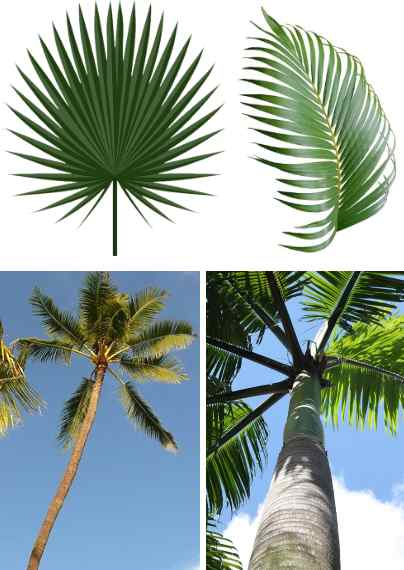
Identification features of palm trees include the foliage shape, height and the torso appearance
Identifying species of palm trees is commonly done by the distinctive shape of the palm fronds (leaves). Generally, leaves of palm trees are either pinnate (feather-like leaves) or palmate (fan-like fronds).
Another way to identify the blazon of palm tree is by the trunk shape. Some of the tallest species of palm copse have long slender single trunks and dwarf varieties usually have brusk fat palm trunks. Some smaller palm tree species may accept clustered trunks with 3 or iv short trunks growing together. At that place are also some dwarf palm copse that just have bushy pinnate fronds growing out the ground and don't have whatsoever trunk at all.
You tin can also tell the species of palm tree past the appearance of the trunk. Some tall palm trees take smooth slender trunks. Depending on the species, these types of trees may have a ringed or bumpy appearance and have a grayish-chocolate-brown color. Some types of palms have trunks covered in fiber or husks that make the torso await hairy or spiky.
Small-scale Types of Palm Trees (Including Dwarf Palm Copse) – With Pictures
Most people who want to grow palm trees in their yard look for minor or miniature types of palm trees. Usually species of miniature or small palm trees are defined as being nether 12 ft. (3.6 m) tall which in terms of palms is quite brusk. Within the small or dwarf palm tree category there are two types of palm trees: bushy palm tree and small palm tree.
Here are some of the most common types of small, dwarf and bushy palm trees.
Cat Palm ( Chamaedorea Cataractarum )
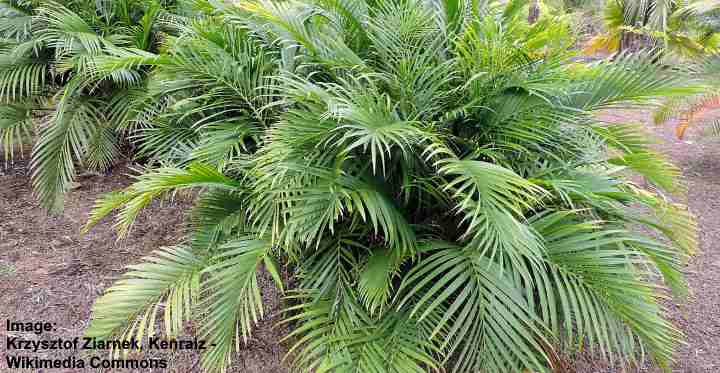
Due to its pocket-size size, cat palm tin be grown indoors
The true cat palm is a small-scale palm found with slender pinnate dark green leaves growing on thin stems that extend straight out of the ground. This trunkless palm tree grows 6 ft. (2 m) loftier outdoors and 3 ft. (1 g) high indoors. In time, the clumping palm forms a dense thicket of shiny slender leaflets.
The identifiable features of a true cat palm are the skinny greenish stems and pinnate leaves, trunkless growth, and flowering stems of yellowish brawl-like blooms. If the palm is pollinated, minor shiny dark-green palm fruits appear that ripen to black ovoid-shaped drupes 0.5" (i.25 cm) long.
The common use of this pocket-sized palm is as a garden plant in warm climates. However, due to its clumping, bushy habit, it is one of the few palm plants that tin be used as an evergreen hedge constitute. In colder climates, cat palms are ideal for growing in pots indoors if at that place is plenty of sunlight.
Further reading: Cat Palm – Care and Growing Guide.
Pygmy Appointment Palm (Phoenix roebelenii)
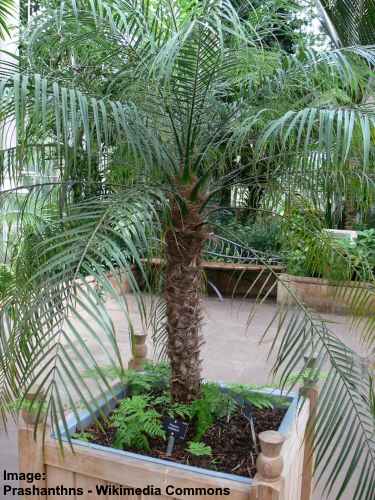
The pygmy appointment palm is a blazon of niggling palm tree with spiky body
As its common name suggests, the pygmy date palm is a small-sized palm tree. This is a truthful type of palm in the family unit Arecaceae and it doesn't grow taller than 10 ft. (3 g). The small palm tree can be identified by its single stem with long bushy pinnate fronds that measure around 3 ft. (1 m) long.
This palm species is an excellent ornamental flowering tree for subtropical landscaped gardens. The arching-drooping fronds of pygmy date palm are large and showy and almost hide the spiky-looking trunk. These curt palm trees also grow well in containers.
Although pygmy palm trees produce dates, the fruit generally isn't equally tasty as dates that grow on larger date palms.
Pindo Palm (Butia capitata)
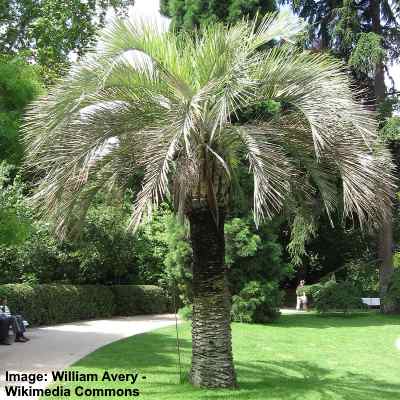
Pindo palm tree is classified as a slow growing, cold-hardy and small palm tree variety. It's an excellent palm tree for residential landscapes.
Likewise named the jelly palm, Pindo palm trees are a species of cold-hardy palms. Although the mature palms tin can reach a acme of 15 to xx ft. (4.5 – vi m), they are a deadening-growing species of palm. This means that they are suitable for gardens where small palm copse are required.
These short palm trees thrive in full sun or fractional shade and are tolerant of near soil types. The fruit of the palm copse are a light orange to brownish color and are used to make jelly – hence the name 'jelly palm.' The palm is particularly attractive when it flowers with cerise, yellowish, or white blossoms.
Triangle Palm (Dypsis decaryi)

The Triangle Palm has pinnate fronds that fan out from a single torso
The Triangle Palm is the common name for the Dypsis decaryi palm which is in the pocket-sized to medium-sized category of palm copse. The Triangle palm is identified past its extremely long pinnate fronds that grow up to 8 ft. (2.5 m) long. The interesting feature about the fronds is that the leaflets point out at 120° giving the fronds a triangular shape on the cross-section.
Looking at pictures of this palm tree, you can see some other reason why it's called the triangle palm. The leaves fan out from a single gristly stem to grade a singled-out triangle shape. This a very ornamental type of palm tree for subtropical and tropical gardens. The Triangle palm is ideal in a landscape as a backyard tree.
Mediterranean Dwarf Palm (Chamaerops humilis)

The Mediterranean Dwarf Palm has few trunks and is pocket-size plenty to accommodate many gardens
Also called the European Fan palm, this species of flowering palm is a pocket-size-growing tree. The Mediterranean Dwarf Palm (Chamaerops humilis) has a few clustered trunks that make the palm wait more than like a shrub than a tree. In warm climates, this small palm species grows to between 10 and 20 ft. (2 – 5 m) tall.
The palm fronds are light green to silver-green in colour and grow in a fan shape. The leaflets are between 20" and thirty" (50 – 80 cm) wide and each leaf is up to v ft. (i.5 m) long.
The Mediterranean Dwarf palm is prized for its ornamental value and cold hardiness. Although the palm thrives in the hot lord's day, information technology can withstand temperatures as low as 10 °F (−12 °C). The elegant palm can give gardens a tropical wait fifty-fifty if you live in temperate climates.
Mazari Palm (Nannorrhops ritchiana)

The Mazari palm is common cold hardy and looks more similar a palm bush
The Mazari palm is more of a shrubby bush than a palm tree. Native to southwestern Asia, the Mazari palm has palmate (fan-similar) leaves that grow on clusters of stems. The fan-shaped leaves can measure between i and 4 ft. (30 – 120 cm) long.
Apart from the striking wait of its leaves, the other interesting feature of the palm is its color. The fronds are a silvery-green or silver-blueish color and the long tapering leaflets requite the palm a spiky appearance.
Like other types of common cold-hardy palm copse, the Mazari palm needs hot summers to grow well. Even so, this species is also cold-hardy downwardly to 10 °F (−12 °C).
Dwarf Majesty Palm (Ravenea hildebrandtii)

The Dwarf Majesty palm tree is common both indoors and outdoors due to its miniature size
Ane of the most popular short palm trees for gardens and landscaping is the Dwarf Majesty palm tree (Ravenea hildebrandtii). This is a single-trunk palm with dark greenish pinnate leaves. The body is slender and is simply 3" (vii cm) thick and the palm tree doesn't grow taller than 8 ft. (2.four m).
The large wide arching leaves look imperial as the focal point of whatever subtropical ornamental garden. The bright green leaves can grow up to iii ft. (100 cm) long and take upwards to 100 leaflets growing along the stem. The contrast of the slim trunk and wide crown of foliage can grace any garden. You lot can likewise grow this palm in containers.
Majesty palm is one of the best potted palm trees to grow outdoors.
Christmas Palm Tree (Adonidia merrillii)

The Christmas palm tree is a pop choice in many gardens
If y'all are looking for a miniature type of palm tree for your garden, then the Christmas palm (Adonidia merrillii) is an fantabulous choice. This ornamental palm tree is modest when compared to other tall coconut or engagement palms. Some reports indicate that the Christmas palm tree is one of the most popular ornamental types of palm on the planet.
This small species of palm tree doesn't grow taller than 25 ft. (seven.vi m), however, some smaller varieties only grow to 15 ft. (4.5 g). Large pinnate palm leaves curvation up from the top of the stem to form a cute crown of green leaf.
Canteen Palm Tree (Hyophorbe lagenicaulis)
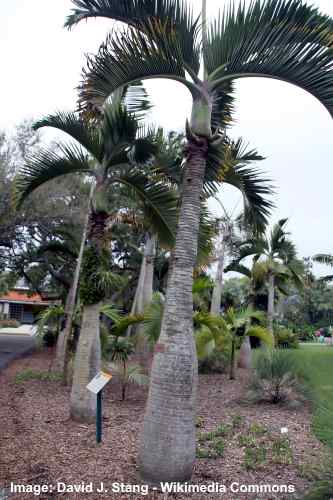
The small ornamental Bottle palm tree has a thick short torso
The Canteen Palm tree gets its proper noun from the bottle-like shape of the curt fat trunk. The identifying feature of this small palm tree is the enlarged trunk that looks bloated at the base. This helps to differentiate this palm species from the Spindle palm which swells in the middle of the fatty body.
At the top of the ten ft. (3 one thousand) high body are 3 or 4 huge palm leaves. At maturity, these pinnate leaves can grow to 12 ft. (three.6 g) long and take leaflets that are 2 ft. (0.6 k) long.
These bottle palms grow well in states such every bit Florida and California. Or, you can grow them in containers and bring them indoors during winter.
Sago Palm (Cycas revoluta)
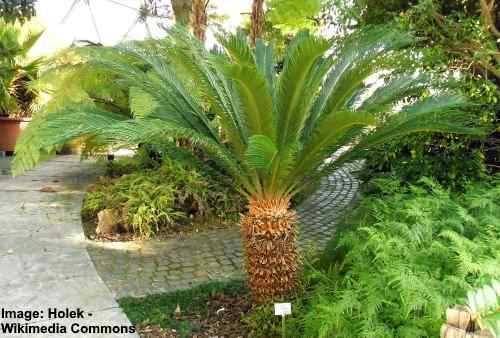
The Sago palm is non a true type of palm tree
Although the Cycas revoluta is named the Sago palm, it is non a true variety of palm tree. The Sago palm belongs to the family unit Cycadaceae which may look like a palm but is botanically dissimilar. This 'palm' is identified by its short body and fern-like new leaves.
Related: Amazing Pocket-size or Dwarf Palm Trees.
Ruby-red Sealing Wax Palm / Lipstick Palm ( Cyrtostachys renda )
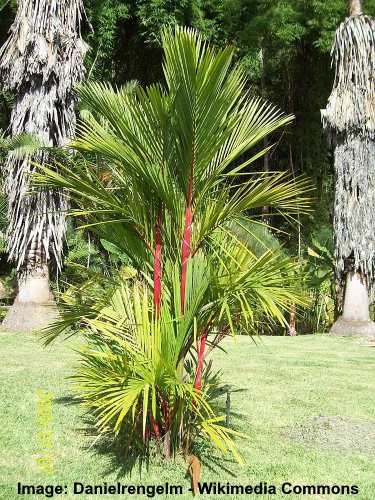
Reddish sealing wax palm is a small tree with distinctive blood-red leaf stems
The ruby sealing wax palm has a recognizable bright red crown shaft and leaf sheaths. Also called the carmine palm, this clumping palm variety tin can grow x – twenty ft. (3 – vi m) tall. Information technology has long pinnate leaves, greenish flowers, and dark blue-blackness fruits. Mature red palms accept heart-catching greenish and crimson stems.
The ruddy-colored crown-shaft and bright red foliage stems brand the ruddy sealing wax plant piece of cake to spot in landscapes. The beautiful palm is suitable for growing in USDA zones 10 and 11. However, if you lot want to savor the beauty of this blood-red palm, you can also abound it in pots indoors.
Arikury Palm ( Syagrus schizophylla )
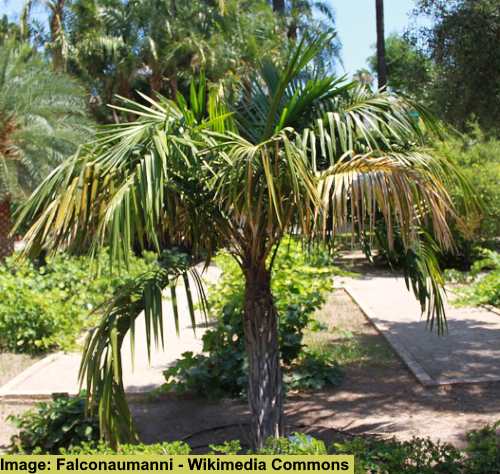
Arikury palm is a dwarf tree suitable for pocket-size gardens
The arikury palm is a minor ornamental palm tree with arching, olive to dark-light-green fronds forming a spreading crown. This popular accent palm is perfect for meaty gardens because it doesn't grow taller than six ft. (1.viii g). The evergreen palmate leaves measure 4 to half dozen ft. (1.ii – 1.8 m).
Suitable for subtropical landscapes in USDA zones 9 to 11, the arikury palm is recognized past its arching, apartment leaflets growing on very long jagged petioles. Additionally, the palm blooms with stake yellow flowers on thick arching, pendulous stems measuring upward to 3 ft. (1 m) long.
An identifying characteristic of the arikury palm is its toothed leaf stems — a unique feature that palm species of the Syagrus genus rarely have.
Other Types of Palm Tree (With Pictures and Names)
Depending on your climate and the type of garden y'all have, there are many species of alpine palm trees that look majestic in subtropical and tropical gardens.
Kokosnoot Palm ( Cocos nucifera )
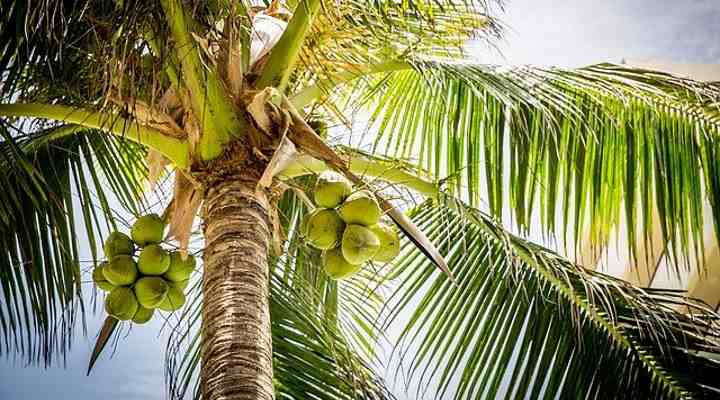
Coconut palm tree grows up to 100 ft. (30 one thousand) tall but there are dwarf varieties to accommodate smaller spaces
The coconut palm tree is one of the most easily recognizable types of palms. This tall palm tree grows up to 100 ft. (30 m) tall with a grayish-dark-brown, slightly curved smooth body and recognizable sprawling, drooping palm fronds that measure 15 – 20 ft. (4.v – 6 k) long.
Coconut palms are likewise known for their tropical fruits, described as the "gustation of paradise." The coconut fruit is a big light-green or yellow when immature. The recognizable mature brown coconut seed is covered in a hairy cobweb and is located inside a thick husk. The edible portion of the coconut is the white meat institute inside the wood-like shell.
A coconut palm tree tin produce upward to 75 fruits per year. The large, circular fruits grow in bunches, shut to the central stem and among the leaf stems.
Coconut palm copse typically abound in coastal areas where they thrive in sandy, salty soils. In southern states and tropical countries, yous volition often encounter coconut palms growing forth beaches, streets, and parks.
There are many dwarf coconut palm tree varieties if you lot don't accept space for a tall tropical palm in your grand. An example of a dwarf coconut landscaping palms not growing taller than 5 ft. (one.five m) is the 'Malayan Dwarf.'
Although you can grow kokosnoot palms indoors, they are challenging to grow successfully. Usually, areca palms are easier to abound indoors if you want an evergreen leafy tropical houseplant constitute.
Date Palm Tree ( Phoenix dactylifera )
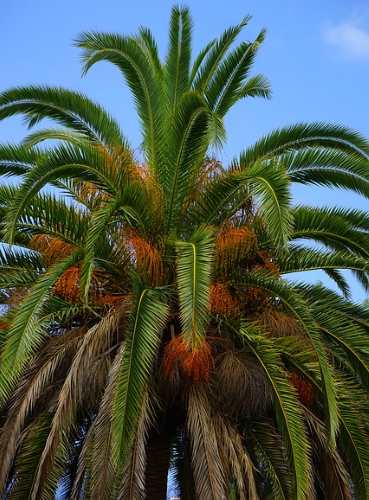
Engagement palm trees are very tall and produce delicious fruit
The date palm tree is one of the easiest palm trees to identify due to its abundant clusters of succulent dates. In add-on, the cute palms have an identifiable long rough body, a crown of arching feathery fronds up to 20 ft. (6 chiliad) long, and clusters of brown, scarlet, or xanthous fruits.
Date palm trees are tall and abound 70 to 75 ft. (21 – 23 1000) high. The spiny leaf stems can measure betwixt 13 and 20 ft. (iv – 6 k) long. The vast leaves have upwardly to 150 leaflets that are 12" (30 cm) long. In full, the date palm's impressive light greenish crown can be betwixt 20 and 30 ft. (6 – 10 m) wide.
Appointment palm trees are best known for their delicious sweet sticky fruits, which are a type of berry. The edible oval fruits are typically night brown with wrinkled peel. However, other varieties of date palms tin produce deep red, blackness, yellow, or golden yellowish bunches of dates.
California Fan Palm ( Washingtonia filifera )
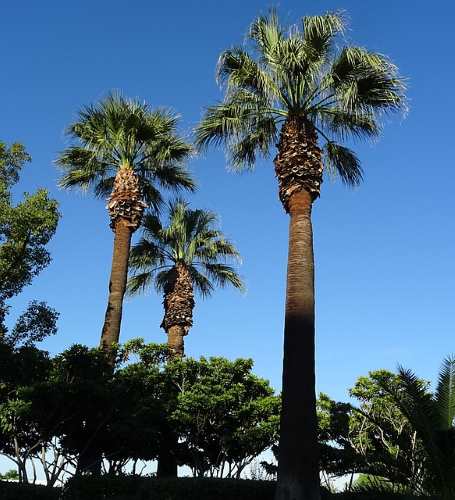
The ornamental California fan palm is identified by its fan shaped fronds
The California fan palm is a medium-sized ornamental palm tree with long, fan-shaped fronds with fibrous threads and a sturdy columnar trunk. The identifying characteristic of the California fan palm is its spectacular leaves made upward of waxy green blades that spread out in a fan shape.
This palm tree grows between 40 and 60 ft. (12 – xviii m) tall.
Other identifying features of the California fan palm are its grayish and tan trunk that stands erect. In addition, it's like shooting fish in a barrel to recognize California palms due to the brim-like shape of dead fronds almost the peak of the tree. After the gray-green leaves die, they droop down and plow brown.
This hands identifiable palm tree also goes by the name petticoat palm due to the palm'southward distinctive crown. The recognizable fan shape of the leaves also gives it the name desert fan palm.
Its botanical name Washingtonia filifera refers to the thread-like strands on the green palmate leaves.
Chilean Wine Palm ( Jubaea chilensis )
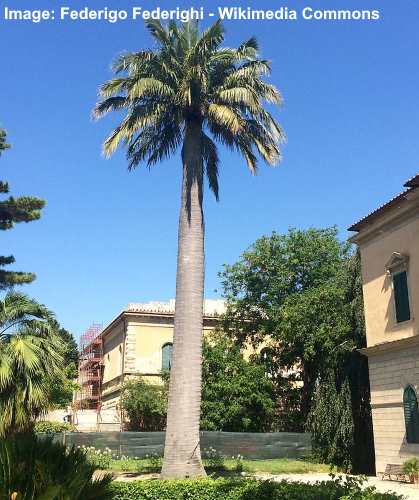
The slow growing Chilean wine palm has a smooth gray trunk
The Chilean wine palm is a tall palm tree, identified by its thick, columnar, smooth gray trunk, long arching plumage-like greenish fronds, and stunning crown. The identifiable characteristic of this hardy palm is its wide, direct trunk measuring up to 3 ft. (i 1000) in diameter, which is swollen at the base.
Considered one of the most impressive palm trees in the world, the Chilean wine palm grows 60 to 80 ft. (xviii – 24 one thousand) tall. The dumbo, up growing crown consists of palmate fronds measuring xv ft. (iv.5 k) long. Unlike many palms with fibrous trunks, this palm species has a smoothen grayness trunk. Additionally, small purple and yellowish flowers bloom in summer, calculation to the palm's grace and dazzler.
When the palm is relatively immature, it has a stumpy advent with an explosion of large arching fronds. The palm's tiresome growth means that it takes many years to reach its mature height.
Although native to Chile, this single-trunked palm tree is cold hardy, and can thrive in temperate climates. You can find Chilean wine palms growing in Ireland, Northern and Southern California, and Due south Africa. The palm also goes by the common names dearest palm, palm honey tree, and Chilean coquito palm.
Florida Royal Palm ( Roystonea regia )
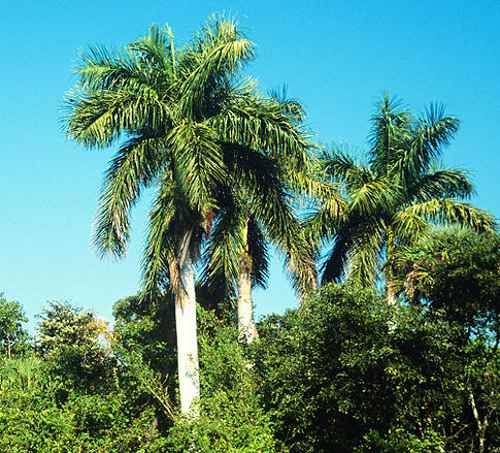
The Florida purple palm is identified past a smoothen erect pale trunk and bushy crown
The Florida imperial palm is a majestic palm tree with a alpine, smoothen, relatively skinny greyness-white body, a stunning crown of arching dark dark-green fronds, and rounded red or purplish-black palm fruits. Identifying features of this palm tree are its shine green crownshaft, bulging stem base, and erect trunk growing 65 to 100 ft. (20 – thirty thousand) tall.
The palm's distinctive crown comprises 15 arching fronds measuring thirteen ft. (four thou) long. Minor pinkish-white flowers appear in tardily spring. After pollination, the palm tree produces fruit—circular drupes 0.six" (ane.5 cm) long and 0.4" (one cm) wide. The slender, smooth torso and bushy crown invoke idea of tropical landscapes
This smoothen, tall Florida palm has the unusual growth habit of shedding its old fronds. These expressionless leaves peel off from the crown, revealing a smooth dark-green torso. Yous volition find this ornamental street palm growing in Florida, Texas, Southern California, and Hawaii. Roystonea regia is the national tree of Cuba.
Açaí Palm ( Euterpe oleracea )
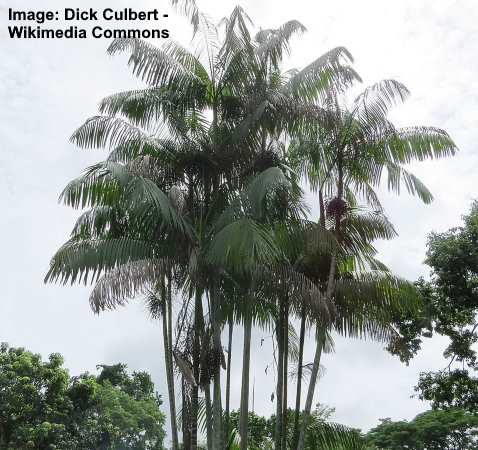
The açaí palm has multiple skinny tall trunks
The acai palm tree is a skinny palm tree with multiple clustering stems that grow upwardly to 65 ft. (twenty m) tall. The acai palm is identified by its bunches of berry fruits one" (2.5 cm) in diameter and long, pinnate leaves growing upward to 10 ft. (3 chiliad) long.
Acai palms are native to South America, where they grow in swamps and floodplains. The most valuable feature of the acai palm is its berries. Acai berries are pocket-sized black drupes that abound abundantly on drooping stems. There can be between 500 and 900 fruits in a single bunch.
Peach Palm ( Bactris gasipaes )

The peach palm has a unique round spines on its trunk
The peach palm is a fruit-producing palm tree that has clusters of red palm fruits. Peach palms with their red fruits abound around 66 ft. (20 m) alpine. The multi-stemmed tree has spiky crowns of pinnate fronds that are 10 ft. (3 m) long.
Peach palms are a type of tall clumping palm tree with edible fruit. The pulpy palm fruits are typically ruby-red. Withal, other varieties of peach palms can have yellow or orangish peach-like fruits.
An identifying feature of a peach palm is its spiny torso. The slender body measures (ten – 25 cm) in bore. Nonetheless, upwards close, pictures of the torso reveal that the palm tree has thorns in circular bands around the brownish-gray trunk.
Oil Palm ( Elaeis guineensis )
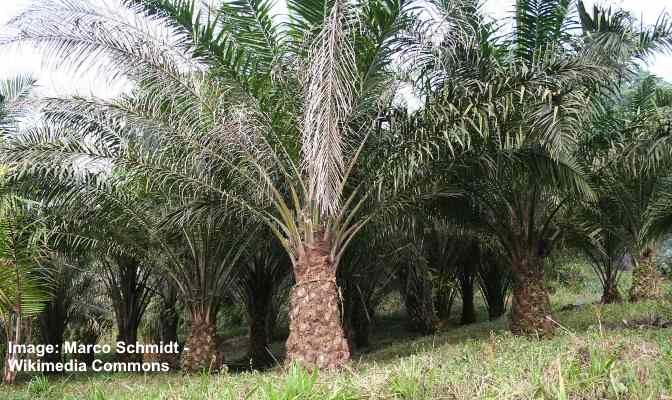
Oil palm fruits are commonly used in oil production
The oil palm is famous for the oil that is pressed from its fruit. Oil palm copse grow over 66 ft. (20 m) tall and have massive pinnate fronds measuring 10 to 16 ft. (3 – 5 thou) long. The valuable fruit from the tree grows like red palm berries about the size of a plum.
The oil palm is a single-stemmed diverseness of palm tree. The attractive palm leaves grow in an upwardly, arching habit, giving the decorative tree a vase-shaped appearance. The palm'south recognizable characteristic is the large bunches of 200 to 300 red palm fruits growing shut to the trunk.
Oil palm fruit is an egg-shaped, oblong drupe measuring up to 1.4" (3.v cm) long and 1" (ii cm) wide. The oily pulp is used to produce palm oil, whereas oil pressed from the seeds is sold as palm kernel oil.
Foxtail Palm ( Wodyetia bifurcata )
The foxtail palm tree is an impressive medium-sized palm tree due to its massive arching or curled fronds measuring 6.5 – 10 ft. (2 – three 1000) long. The ornamental palm is identified past its plume-like leaf that looks like a bushy fox's tail—hence the name foxtail palm.
Some other identifying feature of the foxtail palm is its large egg-shaped orange palm fruit. The oval fruits emerge olive green, ripen to an orangish or deep ruby-red color, and measure ii" (5 cm) long.
The foxtail palm is a type of smooth palm tree due to its self-cleaning nature. The palm tree grows 30 ft. (10 yard) tall and has a light-gray to white trunk. Like the Florida purple palm, expressionless fronds drop from the crown, revealing a smooth dark-green trunk. Looking at the palm tree bark close, y'all'll observe distinctive rings effectually the gray torso.
Guadalupe Palm ( Brahea edulis )

The pocket-size and irksome growing Guadalupe palm is a popular landscaping tree
The Guadalupe palm tree is a small palm plant with fan-shaped leaves growing on the stems, a rough, brown fibrous alone torso, and sweet blackness palm fruits. Guadalupe palms grow xv to 40 ft. (4.5 – 12 thousand) tall and are a dull-growing palm type.
The distinctive characteristic of the Guadalupe palm is the potent leaflets growing in the shape of a fan at the end of long smooth stems. In the mural, these palm trees make a dramatic statement due to the spiky appearance of the dense crown. Every bit a effect, the ornamental palm is a popular landscaping palm tree in California.
You can identify Guadalupe palms in the summertime due to their fragrant, flossy yellow blooms growing in amongst the leafage. After flowering, the palm produces deliciously sweet palm fruits that you tin can swallow fresh or apply in cooking.
Bismarck Palm ( Bismarckia nobilis )

The modest Bismarck palm tree has beautiful silvery gray leafage and is cold sensitive
The Bismarck palm is an easily identifiable palm due to its vast fronds of steely-blueish or silvery gray spiky leaflets. The fan-shaped palm leaves grow in all directions, creating a spectacular pale green spherical crown that is twenty ft. (six m) tall and 24 ft. (7.5 m) wide. Its stout, curt body adds to the palm's visual appeal.
The heart-catching silvery-blue leaves look like a round spiked fan and can grow over ten ft. (iii m) wide. This slow-growing palm tree eventually reaches around 40 ft. (12 thousand) tall in gardens and parks. It is a popular landscaping palm in Florida, Southern California, Texas, and Arizona.
Some other feature of the Bismarck palm tree is its small brown egg-shaped fruits. These chocolate-brown rounded drupes grow in bunches similar grapes dangling from this stout palm tree. Individual fruits measure ane.5" (iii.eight cm) long and grow densely on four ft. (1.2 m) long stems.
Proctor'south Argent Palm, Cayman Thatch Palm ( Coccothrinax proctorii )
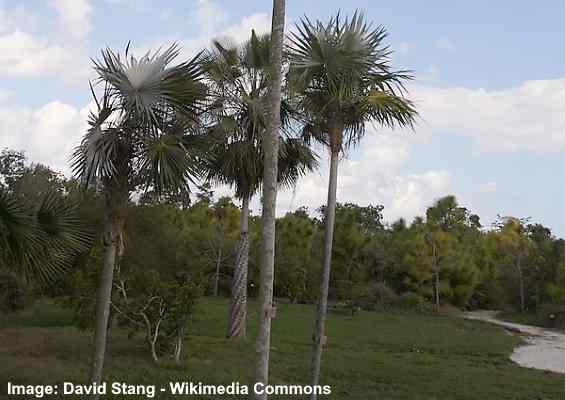
Proctor's silvery palm has a skinny trunk and fan shaped leaves and is slow growing tree
The Proctor'south silverish palm is a medium-sized palm tree with a single skinny trunk and dark light-green fronds, creating a symmetrical crown. This slow-growing tropical palm tree grows between 10 and 20 ft. (3 – 6 m) high. As the majestic palm tree matures, the trunk gradually becomes smooth and grey.
Cayman thatch palms are native to islands in Central America. The palm tree has feature fan-shaped leaves that are typical of palms growing in tropical or subtropical climates. In addition, Cayman thatch palm leaves class an open rounded or triangular crown. Considering it's dull-growing, you tin apply the palm every bit an attractive landscaping plant or specimen tree.
MacArthur Palm ( Ptychosperma macarthurii )
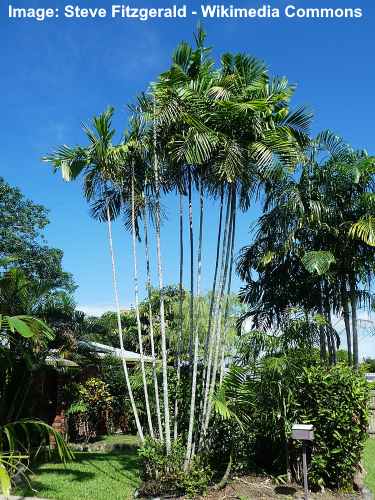
MacArthur palm is identified by multiple tall skinny trunks
The MacArthur palm tree is a tall skinny palm tree with multiple stems that grow up to 33 ft. (10 m) alpine. The MacArthur palm is easy to identify in the landscape due to its clumping addiction, slender, smooth trunks, green crownshaft, and rounded spiky crown.
MacArthur palm leaves abound up to 10 ft. (3 m) long and accept between 30 and 80 leaflets measuring 22" (56 cm) on each leaf stem. The dense palm crown tin have betwixt 3 and xiii fronds, giving the slender palm tree the characteristic look of tropical landscapes.
In the landscape, MacArthur palms grow as multi-stemmed palm trees, making them hands identifiable. Other identifying traits of the palm are a whitish body with dark rings, clusters of xanthous-greenish flowers, and bunches of pocket-sized bright red fruit.
Canary Palm Tree (Phoenix canariensis)
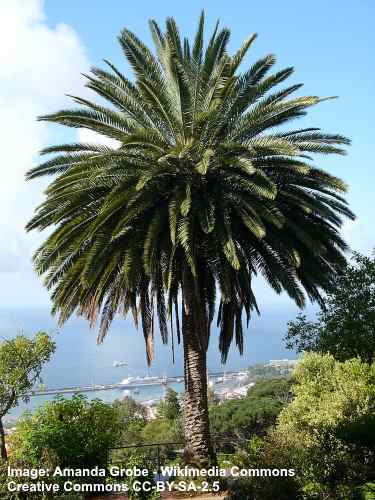
The cute Canary palm tree has a tall body with large leaves
1 of the most elegant palm trees you can abound is the Canary palm tree (Phoenix canariensis). The palm tree is identified by the large pinnate leaves that await like an explosion of foliage at the top of tall palm trunks.
Depending on the climate, Canary palms grow to betwixt 33 and 66 ft. (x – 20 thousand) alpine. The nighttime-light-green leaves are xiii – 20 ft. (four – 6 m) long and form an elegant crown. Existence a species of palm tree from the Phoenix genus, Canary palm trees as well produce edible dates.
Sylvester Palm Tree (Phoenix sylvestris)
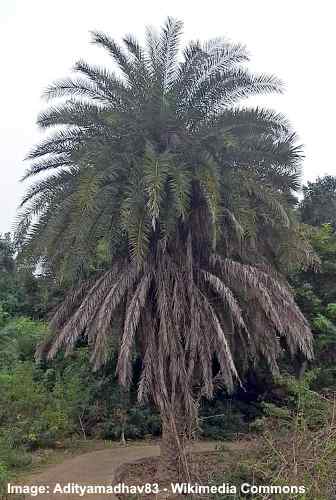
The Sylvester palm has different species which vary in pinnacle
Related to the Canary palm tree is the Sylvester palm tree (Phoenix sylvestris). This date-producing palm tree is native to India, Pakistan, and Nepal. Some species of the Sylvester palm can be as short as 13 ft. (4 m) and others can grow up to 50 ft. (15 g). Large arching pinnate leaves grace the elevation of this single long stem.
Chinese Fan Palm (Livistona chinensis)
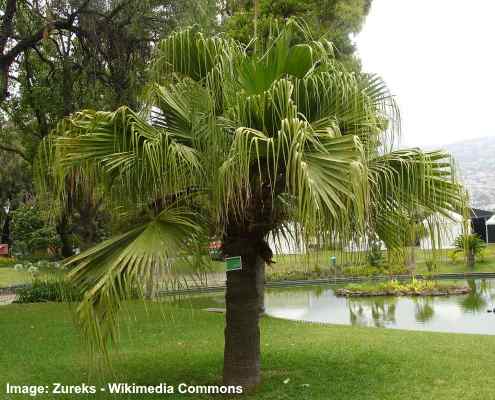
The ornamental Chinese Fan palm looks attractive in whatever landscape design
Native to Asia and the Far East, the Chinese Fan palm (Livistona chinensis) is a single-stemmed palm with ornate drooping leaves. The palm gets its name from the fan-shaped (palmate) leaves. These arch out from the summit of tall thick stems that grow to between thirty and l ft. (9 – 15 m) high. The tree has a spread of up to 12 ft. (4 1000).
Palmetto Palm Tree (Sabal palmetto)
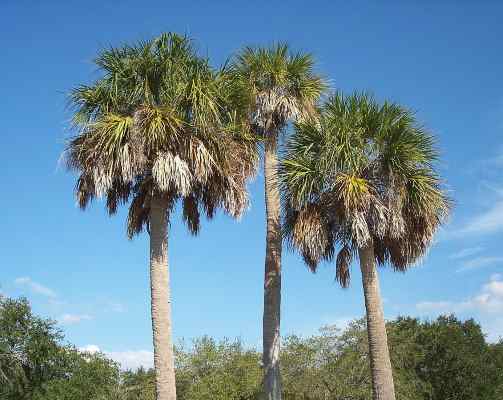
The Palmetto is a blazon of tall palm tree
Palmetto palms are a species of tall-growing, elegant palm tree in the genus Sabal, and subfamily Coryphoideae. Sabal Palmetto palms are identified by their striking spiky-looking leaves in a fan shape. The straight thick trunks of these alpine palm copse stretch up to 65 ft. alpine (20 m).
If these trees remind you of beaches in S Carolina and Florida, that is because Palmetto palms are the official tree of these states.
The palmetto palm is native to Florida and it'southward one of the mutual types of palm copse in Florida.
Mexican Palm tree (Washingtonia robusta)

The Mexican Palm tree has tall and skinny torso
Also chosen the 'Mexican washingtonia', this species of palm tree has a long narrow trunk and bushy-like leafy foliage at the top. The other name for the species Washingtonia robusta, the Mexican Fan palm, gives an indication of its foliage shape. Palmate fanned leaves measuring up to 3.3 ft. (one k) long sit gracefully on top of 82-ft. alpine (25-m tall) stems.
Clusters of edible fruit grow on this engagement palm, although the dates aren't as tasty as dates from other types of palms.
Windmill Palm Tree (Trachycarpus fortunei)
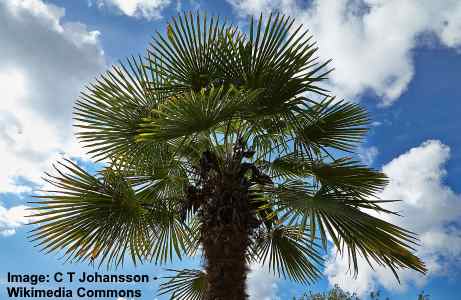
The Windmill palm tree is very hardy and has long slim torso
The Windmill palm tree is native to Prc and Nippon and is 1 of the hardiest species of palm tree. This evergreen perennial palm tree has long slender trunks that can abound upward to 66 ft. (twenty yard) tall. The fan-shaped leaves, crude body, and wispy palm appearance are identifying features of this alpine palm tree.
King Palm / Bangalow palm ( Archontophoenix cunninghamiana )
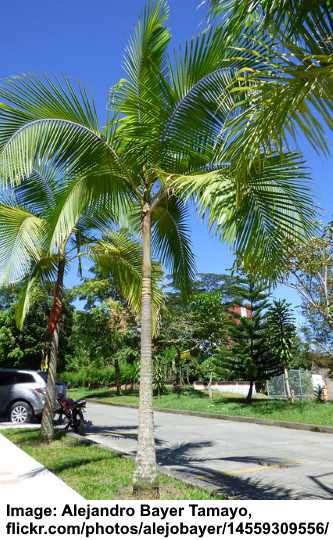
Male monarch palm is a alpine tree with a slender trunk
The male monarch palm tree is a cute palm identified past its attractive crown of bright green fronds, grayish bark, pink flowers, and clusters of bright cherry dates. The king palm thrives in tropical and subtropical climates. The palm tree has an attractive crown-shaft consisting of 15 to 20 large arching fronds.
Besides chosen the Bangalow palm or Illawara palm, the tall palm tree tin grow over 65 ft. (xx m) tall. Its huge evergreen fronds measure around fifteen ft. (4.5 chiliad) long, consisting of up to 150 leaflets that are half dozen" to 12" (15 – thirty cm) long. Like virtually palms, rings around the erect, slender trunk attain up to the smooth greenish-brown crown-shaft.
Red Latan Palm Tree ( Latania lontaroides )
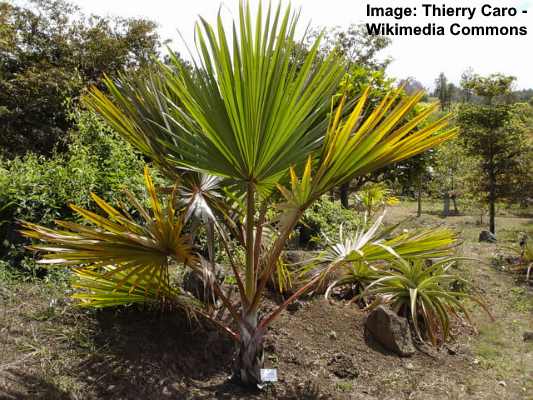
Crimson latan is a medium sized boring growing palm tree
The red latan is a medium-sized palm tree with a distinctive spiky appearance. In improver, this tropical palm tree has characteristic fan-like fronds consisting of potent, spiky leaflets. The attractive palm tree fronds measure 8 ft. (2.four m) wide and create a beautiful, rounded crown with a 20 ft. (vi chiliad) spread.
An identifying feature of red latan palm trees is the reddish leaves and stems growing on immature trees. Equally the slow-growing palm tree matures, it reaches a acme of xxx to xl ft. (9 – 12 thousand). Mature red latan palms have dark-green foliage with a white, silvery appearance.
Other features that help identify the red latan palm are clusters of yellow spring flowers, dark-brown-green fleshy drupes measuring ii" to iii" (5 – 7.5 cm) long, and a slender grayish trunk with low-cal rings around information technology.
Fishtail Palm ( Caryota mitis )

Fishtail palm is a multi-stemmed tree with distinctive leaves
The fishtail palm is an attractive, multi-stemmed palm tree with light, glossy greenish leaves resembling a jagged fish'due south tail. Masses of pocket-size deltoid leaflets grow on long stems, forming thick layers of ruffled fronds. The clumping palm tree grows around 40 ft. (12 m) alpine and ten ft. (three m) wide.
Apart from its easily identifiable bipinnate fishtail leaves, the fishtail palm blooms with attractive creamy-white flowers, followed by dark red fruits. Unfortunately, the dark drupes on Fishtail palm trees are poisonous and should never exist eaten.
The long shiny palm fronds can grow up to x ft. (3 m) long. The ruffled fishtail compound leaves abound on long stems that give the palm tree a weeping advent.
Montgomery Palm ( Veitchia arecina )
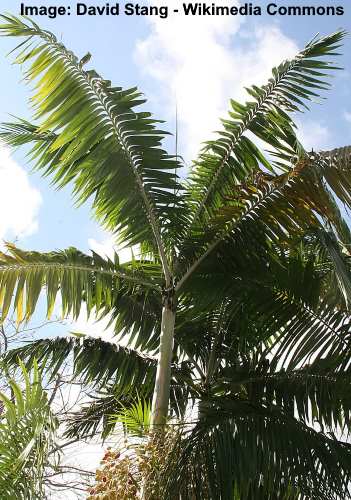
Montgomery palm is an attractive tall tree with a slim body and beautiful crown
The Montgomery palm is a tall solitary palm tree, identified past arching fronds and drooping leaflets, greenish-white blossom clusters, and oval red fruits. Montgomery palms have the characteristic advent of tropical climates. Straight, slender trunks with a svelte spreading crown at the terminate of a polish stake green crown-shaft identify this palm.
Montgomery palms accomplish heights of lxxx ft. (24 m) alpine. The potent, arching fronds grow upwardly to 10 ft. (3 1000) long and contain lanceolate drooping leaflets. In leap, Montgomery palms are identified by clusters of greenish-white flowers measuring 3 ft. (1 m) long growing at the base of the crown-shaft. After blooming, brilliant yellow or blood-red fruits appear on pendulous stems.
Puerto Rican Thatch Palm ( Coccothrinax alta )
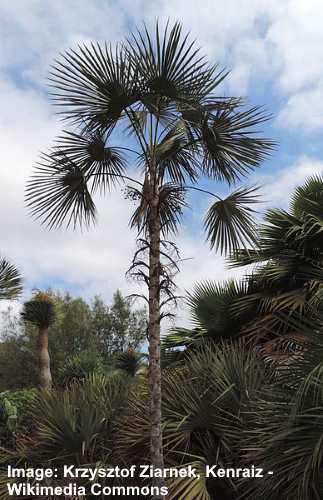
The Puerto Rican thatch palm is hands identified due to its tall trunk and sparse crown
The Puerto Rican thatch palm tree is an exceptionally tall palm with a slender single blank trunk. The identifying feature of the thatch palm is its palmate leaves in a fan shape, creating an open crown. The palm fronds measure out 5 ft. (1.5 1000) across.
Afterward blooming, the yellow flowers on the Puerto Rican thatch palm requite way to purplish-blackness fruits 0.23" to 0.47" (6 – 12 mm) in bore. The palm is easy to spot in a tropical mural due to its erect stalk growing around 50 ft. (15 thousand) alpine and sparse crown.
Everglades Palm ( Acoelorrhaphe wrightii )
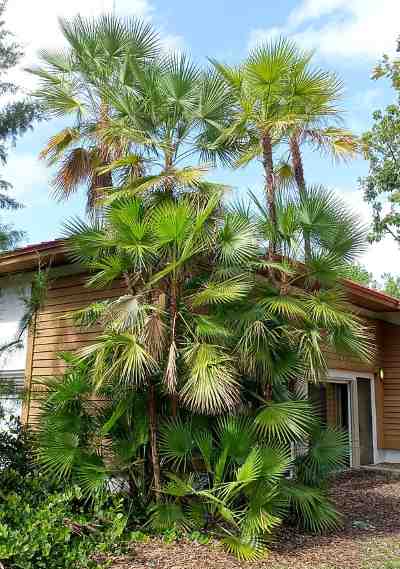
The everglades palm is a small to medium sized tree native to Florida
The everglades palm is a native Florida palm tree with substantial palmate, fan-shaped leaves. The palm is identified by its arching stems with big fronds measuring upwardly to 2 ft. (0.half-dozen m) wide and 18" (45 cm) long. The dull-growing everglades palm tree performs well in marshy, salty soils and full sun.
The everglades palm thrives in USDA zones nine through eleven. Growing in a sunny landscape, the palm tree reaches 20 to 30 ft. (six – nine m) tall and features a sprawling crown up to 25 ft. (7.5 one thousand) broad at the top of a slender trunk. The attractive fan-shaped leaves take a silverish underside, adding to the tree'southward attractiveness.
Saw Palmetto ( Serenoa repens )
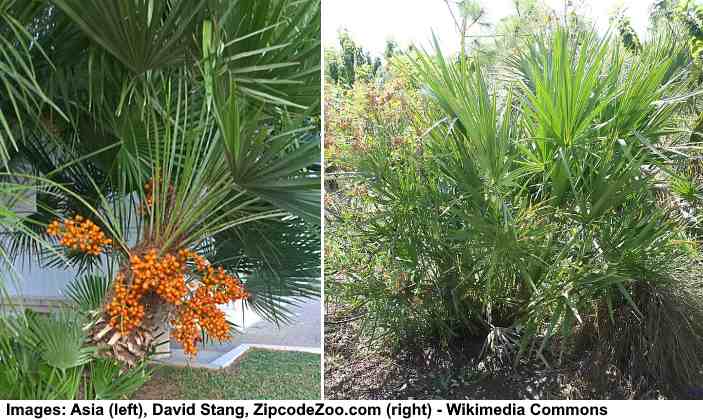
The small saw palmetto tree is suitable for limited spaces
Saw palmetto is a multi-trunked, clumping palm tree growing a mass of fan-shaped palmate fronds emerging from spined petioles. The waxy evergreen palm leaves grow iii ft. (ane chiliad) in bore. Each blueish-dark-green or emerald-green leaflet has eighteen to 30 pointed segments. The palm as well blooms with fragrant, creamy white flowers.
Saw palmetto is a native Florida palm tree that thrives in USDA zones 9 to 11. It's also a species of cold-hardy palm and can survive short spells as low as 20°F (-vi °C). The palm's spreading habit, dense foliage, white flowers, and yellow berries make it a valuable landscaping palm tree.
Queen Palm ( Syagrus romanzoffiana )
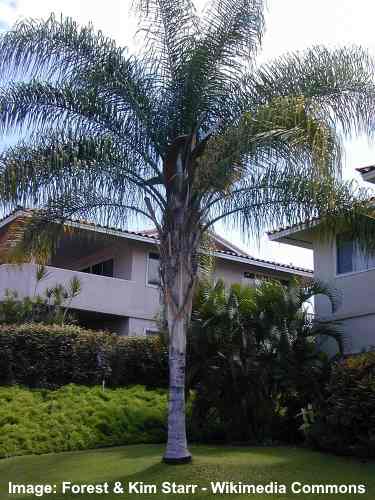
The queen palm is a pop ornamental tree for residential areas
The queen palm is a stylish evergreen tree, identified by its super-long arching fronds. The plumage-like fronds grow between 8 and fifteen ft. (ii.4 – 4.five m) long and grow at the top of a slender, smooth, gray torso. Other features of the queen palm include creamy-white flowers blooming in spring and clusters of yellowish-orangish edible dates.
The queen palm is a sun-loving, heat-loving species that grows l to lxx ft. (15 – 21 m) tall. Despite thriving in the tropics, this fast-growing palm is likewise common cold-hardy to 25°F (-iv°C). The elegant palm tree performs best growing in moist, acidic soil and it has moderate table salt tolerance.
Texas Sabal Palm Tree (Sabal mexicana)
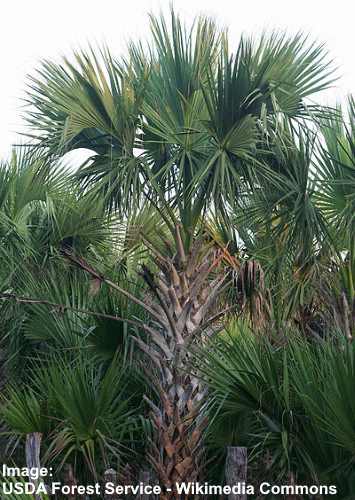
The Texas sabal palm is an attractive tree
Besides chosen the Texas palmetto, the Texas sabal palm is a robust native palm tree with a unmarried trunk topped by big fan-shaped evergreen leaves. The attractive green palm fronds measure upwardly to 6.five ft. (ii thou) wide, growing on 15 ft. (four.5 g) long stems, forming a thick, rounded crown. The sabal palm tree is also identified by clusters of creamy white flowers, and showy, blackness drupes.
The Texas sabal palm grows upward to 50 ft. (15 g) tall and 25 ft. (seven.6 m) broad. Suitable for growing in zones 8 to xi, the sabal palm thrives in high humidity, loamy, well-tuckered soils, and full dominicus. Establish as a specimen tree to give visual appeal to garden landscapes.
Dwarf Palmetto Palm Tree (Sabal pocket-sized)
The dwarf palmetto palm is native to central Texas and northeastern United mexican states. The flowering evergreen palm tree is identified by its fan-shaped leaves that sometimes grow straight from the basis. Its leaves with big, pointed segments measure 3 ft. (1 one thousand) beyond and grow on smooth, spineless petioles.
Other identifying features of the dwarf palmetto palm are its fragrant, creamy-white flowers, and clusters of dark brown or blackness fruits.
Dwarf palmetto palm trees are drought and common salt tolerant, suitable for growing in zones seven – 10. The low-growing, shrub-like tree grows four to 5 ft. (1.2 – ane.v thousand) tall and wide. Its ornamental value makes information technology useful for growing in warm climates as a foundation establish or textural emphasis.
Needle Palm Tree (Rhapidophyllum hystrix)

The needle palm is common cold hardy and can grow equally a miniature patio palm
The needle palm is a cold-hardy, shrub-like palm tree that grows betwixt 3 and 6 ft. (1 – 1.8 m) tall. It has large, lustrous greenish leaves measuring three ft. (1 1000) in diameter with upwardly to 12 strong, slender segments creating an open fan shape.
The needle palm is one of the common cold-hardiest palms, thriving in USDA zones 6 through ten. The palm's dense foliage and low growth make information technology a versatile landscaping plant. Additionally, the shrubby palm grows just as well in full sun as in deep shade.
You can use the ornamental palm as evergreen ground encompass in a shade garden, foundation planting, edge plant, or container plant.
Indoor Palm Trees (With Pictures and Names)
Many types of ornamental palm trees look cute indoors and can provide attractive greenery. Some types of indoor palm plants can be grown in containers in conservatories. Many types of indoor palm tree plants thrive at home, and their 'mini' or 'baby' size makes them a good addition to your houseplants.
Here are some types of palms that abound well indoors.
Parlor Palm

The Parlor Palm is a small depression maintenance tropical palm tree. It is also considered to be one of the lucky plants according to the Feng Shui
Chamaedorea elegans is the botanical name of the evergreen perennial that is known as the Parlor Palm. This small-growing tropical palm tree has reed-like slender stems with lite-dark-green pinnate leaves growing on them. Each stem has half-dozen or 7 leaves that give the palm a bushy advent when a few grow together. Ordinarily, in tropical outdoor areas, these small palm trees abound up to 9 ft. (2.vii m) tall.
However you don't have to live in tropical countries to enjoy this beautiful elegant palm tree. The Parlor Palm is commonly sold as a houseplant and doesn't abound taller than 6 ft. (1.8 m). It is also a very low-maintenance indoor evergreen that can even survive in low-light and dark conditions.
Kentia Palm Trees
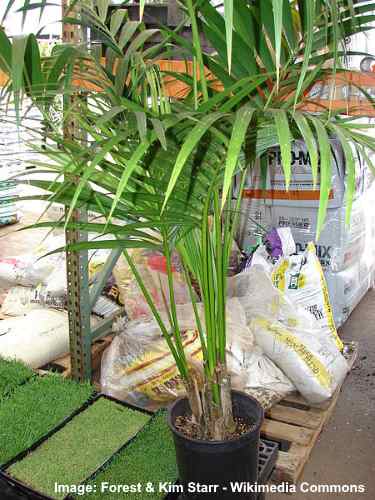
The Kentia palm is a boring growing tree that can exist grown indoors
Although Kentia palm trees (Howea forsteriana) grow up to 40 ft. (12 m) outdoors, indoor varieties of this palm volition max out at most 12 ft. (3 chiliad) tall. Because they are a slow-growing species of palm, they are an splendid selection to grow indoors.
The thin green stems have large palm-shaped leaves that can provide a tropical atmosphere to any kind of room. The ability for Kentia palms to withstand low-light, exceptional watering, low humidity, and cool to warm temperatures make them a perfect indoor blazon of palm.
Lady Palm Trees

The Lady palm is a multi stalk tree that you lot tin abound at home
Rhapis excelsa is the botanical proper name for broad-leafed Lady palms that likewise thrive indoors. This palm is a type of multi-stemmed leafy plant that has a gorgeous bushy advent and can grow up to xiii ft. (iv one thousand) in height. The palmate leaves are dark green and glossy and have unique saw-molar leaf tips. The multiple stems of this palm await similar to some types of indoor bamboo plants.
Ponytail Palm
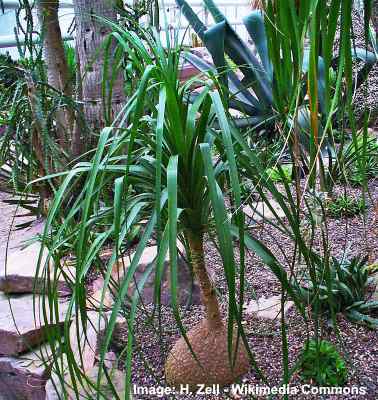
The Ponytail palm tree can grow tall outdoors. Simply is likewise suitable to be grown in a container indoors as an indoor palm constitute
The Ponytail palm tree (Beaucarnea recurvata) is one of the most ornamental indoor palms you lot can have in your room. Other mutual names for this constitute include canteen palm tree or elephant human foot tree.
The ponytail palm tree is neither a palm nor a tree. It is really a blazon of delicious and it's a member of the Agave family.
The Ponytail Palm plant can be identified by its thick brown swollen base of the stem. This distinctive feature is a reason why it's besides called the Elephant's foot palm.
The end of the short fatty palm stem is a fountain of beautiful thin green arching leaves. This bushy display of light-green foliage makes for an attractive indoor tropical palm in sunny locations.
Areca palm ( Dypsis lutescens )
The areca palm is a multi-stemmed plant with arching fronds iii ft. (one m) long, yellow summer flowers, and pocket-sized xanthous-orange palm fruits. This palm has an identifiable butterfly shape due to the multiple stems of palm leaves that curve upward. The areca palm grows 20 – twoscore ft. (6 – 12 m) outdoors in tropical climates.
In colder climates, the areca palm institute is an attractive evergreen ornamental houseplant. The long arching stems tin can grow effectually 6 ft. (i.8 m) alpine. The delightful potted palm leaves have lance-shaped leaflets that grow upward to 6" (xv cm) long.
Other common names for Dypsis lutescens refer to the palm's growth habit and flowers. You may hear this palm chosen the bamboo palm, gilded feather palm, cane palm, or yellow palm.
Further reading: Growing Areca Palm Tree Indoors – Intendance Guide.
Related manufactures:
- Indoor Palm Plants (Including Intendance Guide)
- Impressive Small or Dwarf Palm Trees
- The All-time Types of Palm Trees in Florida
Read Adjacent
Source: https://leafyplace.com/types-of-palm-trees/
0 Response to "Portable Funny Amusing Palm Pressure Mini Fan Fruit Shape Cute Squeeze"
Post a Comment